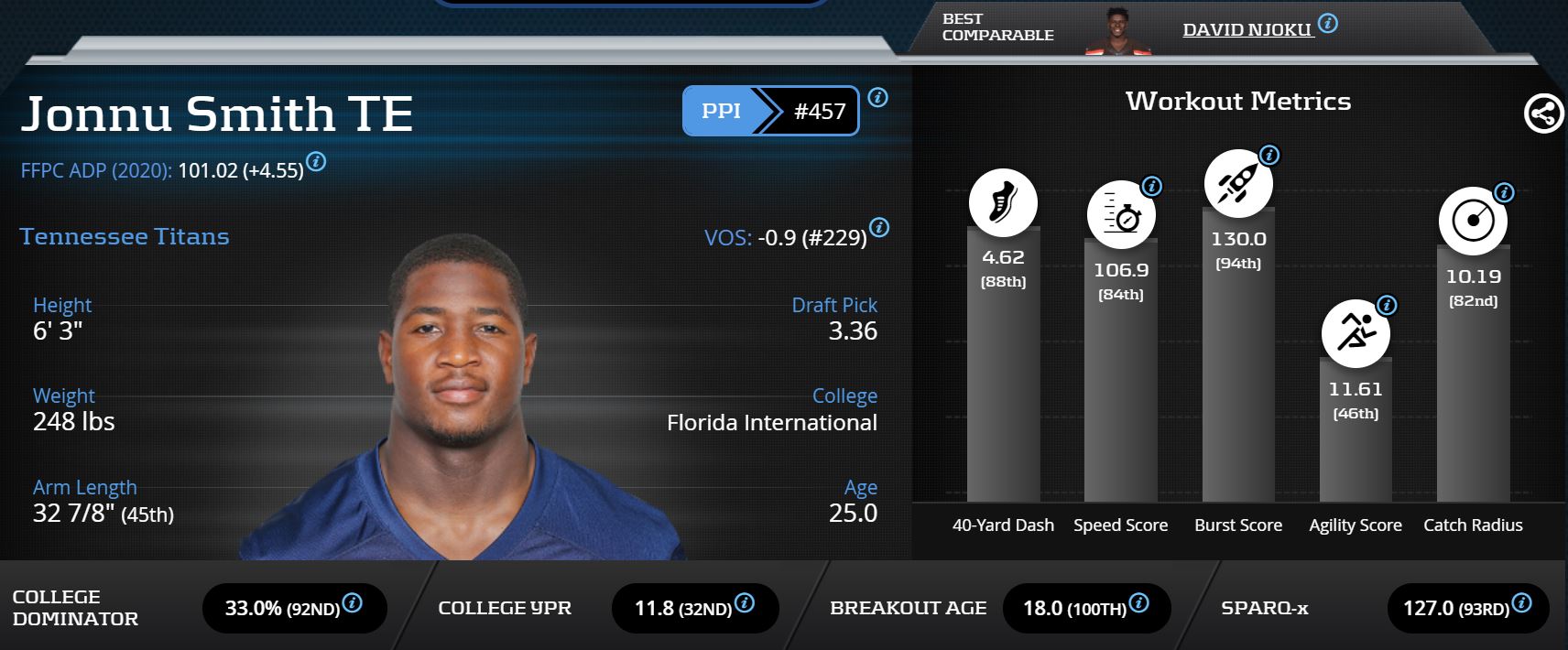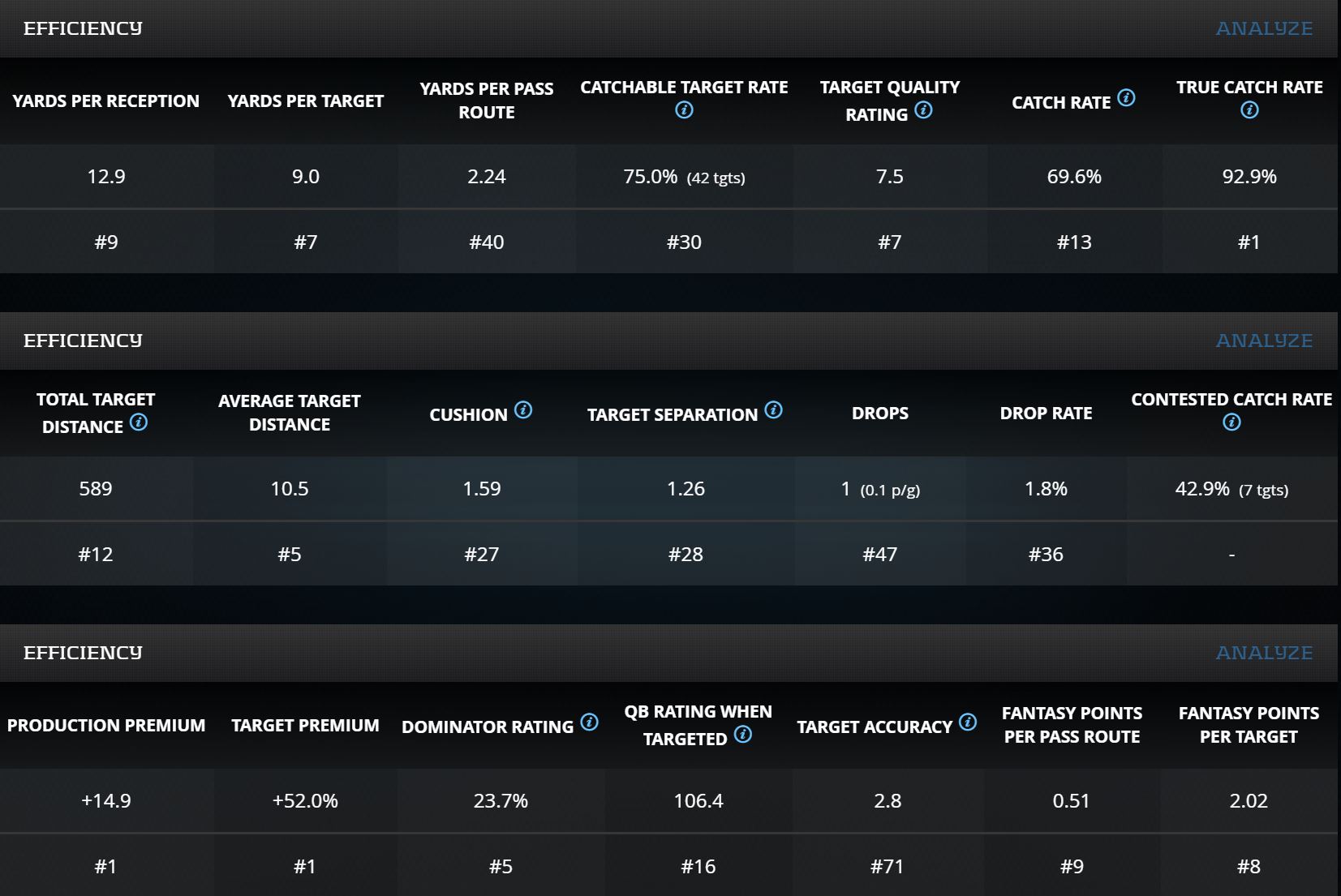From The Podfather firing off warning flares about draft-capital adjusted bust rates and physical fragility rates at the tight end position in 2015, to my recommending players who fit the same stud archetype as Rob Gronkowski and Travis Kelce at a fraction of the cost and risk, we’ve preached a late round tight end strategy in fantasy drafts since PlayerProfiler’s inception. Our advanced stats and metrics pointed fantasy gamers to Tyler Eifert, a league-winning value, in the first year of what’s come to be known as Late Round Tight End Roulette.
The late round tight end strategy is not sexy. There’s a feeling of safety that comes with drafting an elite player at the position. It eliminates the need to scour the waiver wire to play matchups. Given the rise in popularity of leagues with tight end premium scoring and/or multiple flex spots, the allure of picking an elite player at a fragile position is understandable. However, due to the aforementioned fragility rates, tight end output is almost as volatile and difficult to forecast year-to-year as running back output.
https://www.youtube.com/watch?v=k0HN40DXisM
Regardless of draft position, the best-value tight ends in fantasy football over the years have been the 6-5, 250-plus-pounders that see the field on third downs and in the red zone. Also known as the high-leverage fantasy point-scoring situations. Players who fit the league-winning archetype will be available in the final rounds. Mixing and matching one or more, or taking one behind an elite option in the earlier rounds, is the way.
What To Look For
Let’s look at the criteria we seek in pinpointing potential breakout tight ends while examining three players who just miss our cutoff (we’re focusing on players with FFPC ADPs past pick No. 100), but whom fantasy gamers should be prioritizing once the mid-tier landmines are off the board: T.J. Hockenson, Mike Gesicki and Noah Fant.
Size: Hockenson (6-5, 251-pounds), Gesicki (6-6, 247-pounds) and Fant (6-4, 249-pounds) all check this box, but being off isn’t a death sentence depending on a player’s role.
Weight-Adjusted Agility: Elite Agility Scores are always welcome. Hockenson (11.20, 88th-percentile among qualified tight ends), Gesicki (10.86, 99th-percentile) and Fant (11.03, 96th-percentile) all check this box as well.
Opportunity Metrics: Additionally, we like to see Hog Rates at or above 10-percent, along with Snap Shares and Red Zone Target Shares at or near the top of the position. All three players can stand to see their sub-70-percent Snap Shares and sub-20-percent Red Zone Target Shares improve, but all saw Hog Rates above 10-percent. This can be attributed to all three boasting Slot Rates above 25-percent.
Productivity Metrics: The most important metric to focus on here is Yards after Catch. Fant is the winner in this category with 300 (No. 7) Yards after Catch to Hockenson’s 181 (No. 17) and Gesicki’s 173 (No. 21) marks.
Check out Noah Fant’s 2020 Projection on PlayerProfiler’s “World Famous” Draft Kit:
Downfield Efficiency Metrics: We also like when our tight ends are utilized downfield, adding importance to efficiency metrics such as Yards per Target, Yards per Reception, and Average Target Distance. Having high Catchable Target and Target Quality Ratings helps as well. Though all three were outside the top 30 in both Catchable Target Rate and Target Quality Rating, Fant still impressed with 8.4 (No. 11) Yards per Target and 14.1 (No. 2) Yards per Reception. Both Hockenson and Gesicki failed to reach 7.0 Yards per Target or 12.0 Yards per Reception. Gesicki drawing 13 (No. 3) Deep Targets is promising, and his 9.7 (No. 7) Average Target Distance mark leads the group. Both Hockenson and Fant fall outside the top 10 in Deep Targets and outside the top 20 in Average Target Distance. Hockenson’s efficiency would be more worrisome if he wasn’t playing hurt for most of his rookie year.
Other Efficiency Metrics: In addition, pay attention to both Contested Catch Rate and True Catch Rate. Despite none of our three players ranking higher than No. 25 in True Catch Rate, they all hit a Contested Catch Rate of at least 25.0-percent, with Gesicki and Hockenson breaking 30.0-percent. Additionally, a high Target Separation mark will help a player succeed both in the red zone and in the deep quadrants of the field. All ranked outside the top 20 in this metric last year, and improvements would help all three improve their red zone production.
Late Round Tight End Roulette 2020
There’s no shortage of arguments to be made for Late Round Tight End Roulette candidates in 2020, with many Underworld writers having already made cases for a few. Think of this as something of a glossary of late round options at the position. After going through the metrics and different team situations, it’s been decided that this year’s edition of the series will be split into two parts, both focusing on players with FFPC ADPs past pick No. 100. The first part covered players from the NFC, this time we cover players from the AFC.
So (once again) spin that wheel, cut that pack and roll those loaded dice. Bring on the dancing girls, put the champagne on ice and join the Underworld for Part 2 of the sixth annual Late Round Tight End Roulette.
Jonnu Smith (FFPC ADP: 101.02)
I promised I’d write about Jonnu Smith last year when previewing him for the “World Famous” Draft Kit and I forgot, so here we are. Last year’s opportunity metrics weren’t great, though he consistently hovered around an 80-percent Snap Share once Delanie Walker went down in the middle of the year. He’s been efficient throughout his career in spite of bad quarterback play, but was truly unlocked once finally paired with an efficient quarterback in Ryan Tannehill. Despite a 5.5 (No. 35) Average Target Distance mark, his elite athleticism combined with averaging 2.41 (No. 2) yards of Target Separation helped contribute to his 12.5 (No. 8) Yards Per Reception and 9.8 (No. 2) Yards Per Target, as did his 277 (No. 8) Yards After Catch.
We can’t be surprised that a tight-end with a 92nd-percentile College Dominator Rating and 100th-percentile Breakout Age became a fantasy league-winner down the stretch last year. Those who stuck with him through a string of unusable fantasy outings were rewarded in Weeks 14-16. The Titans are one of several teams that made no major changes to their passing game weaponry in the offseason. The chemistry Smith has already formed with Tannehill will be a huge check mark in his favor entering this year. Though Tennessee’s run-heavy nature will keep his ADP relatively suppressed, he enters the year the unquestioned starter. An 85.7-percent Contested Catch Rate on seven targets combined with a 4.4-percent (No. 2) Drop Rate and 89.7-percent (No. 7) True Catch Rate will ensure he remains a trusted component of a passing game destined to see more work.
Chris Herndon (FFPC ADP: 121.54)
Chris Herndon makes the LRTE Roulette cut for the second consecutive season after last year didn’t go to plan. After serving a four-game suspension, subsequent hamstring and rib injuries kept him out of all but one game. For that reason, we need to rely mainly on his 2018 performance to project him into the future. Despite recording 10.5 (No. 5) yards of Average Target Distance and 9.0 (No. 7) Yards per Target, he topped the position with a 92.9-percent True Catch Rate, aided by a 7.5 (No. 7) Target Quality Rating. It makes sense to pay attention to players who end up being productive and efficient in their rookie seasons. Herndon eclipsed 500 yards and finished at or near the top of several important 2018 efficiency metric listings, including Production Premium and Target Premium.
A 21-year-old rookie Sam Darnold was only good enough to provide Herndon with a 2.8 (No. 71) Target Accuracy rating and a 75.0-percent (No. 30) Catchable Target Rate, making his statistical accomplishments all the more impressive. All in all, there’s not a lot to dislike about what Herndon provided in 2018. There’s the 180 (No. 7) Yards After Catch. There’s also the 11.1-percent (No. 17) Hog Rate on a 61.8-percent (No. 30) Snap Share, helped by a 23.6-percent (No. 21) Slot Rate. The Jets are in desperate need of offensive weaponry to take the pressure off Jamison Crowder, and second round draft pick Denzel Mims is dealing with an ill-timed hamstring injury. We may have been a year too early in touting a “Bridge to Herndon” strategy in fantasy drafts.
Jack Doyle (FFPC ADP: 122.00)
It’s not that Jack Doyle is bad, he boasts a 74th-percentile College Dominator Rating and 92nd-percentile Breakout Age, he’s just not that exciting. Though he had a few fantasy TE1 performances last year, his 7.0 (No. 21) Fantasy Points per Game shows he was unusable if he wasn’t being started in the correct weeks.
Though it’s hard to find any metric that he performed well enough in to inspire confidence that he can turn it around this season, most can be explained away by Jacoby Brissett‘s inefficiency. His 228 (No. 14) Yards After Catch and 1.90 (No. 4) Target Separation mark show that he can create on his own despite his poor athleticism. This will be paramount in establishing rapport with new quarterback Philip Rivers, who has been known to utilize his tight ends. Eric Ebron departing for Pittsburgh will also ensure Doyle improves on last year’s 72 (No. 13) targets.
Dawson Knox (FFPC ADP: 165.98)
Dawson Knox is a project. You have to be when you score zero touchdowns in college in spite of an athletic profile with zero workout metrics under the 72nd-percentile. Still, Buffalo saw enough in him to make him a third-round pick in the 2019 NFL Draft. He showed flashes in year one, but dropping six (No. 4) passes contributed to a position-leading 12.0-percent Drop Rate, showing he still has work to do. Though the 50.0-percent Contested Catch Rate on 10 targets isn’t bad. What should excite Bills fans and fantasy gamers going forward is how he was utilized. Despite drawing 10 (No. 6) Deep Targets and averaging 9.9 (No. 5) yards of Average Target Distance, he had a 90.0-percent (No. 5) Catchable Target Rate and a 6.3 (No. 3) Target Quality Rating. He averaged 13.9 (No. 3) Yards per Reception and 7.8 (No. 14) Yards per Target.
Check out Dawson Knox’s 2020 Projection on PlayerProfiler’s “World Famous” Draft Kit:
Josh Allen may have accuracy issues, but put Knox in positions to succeed as a rookie. His dropping so many high-quality looks and ending with a 62.9-percent (No. 39) True Catch Rate is a bummer, but the coaching staff clearly didn’t lose faith in him despite his struggles. His playing time steadily increased throughout the year, and he ended up with a 70.9-percent (No. 20) Snap Share. Entering year two, he’s more qualified to play Buffalo’s deep threat role than recently acquired Stefon Diggs, a splash play possession receiver in all but last season. The team’s run-heavy nature keeps him from beginning the year as an every-week fantasy starter, but he has the athleticism to thrive in his role if he can improve his efficiency. He’ll certainly be worth a look down the stretch when the schedule tightens up and the team is inevitably forced to pass more.
Deep Cuts
Eric Ebron will be intriguing for as long as Ben Roethlisberger can remain healthy. Last year’s 9.9 (No. 6) Average Target Distance and 2.00 (No. 3) Target Separation mark tell us he can bring a deep threat element from the TE position that the Steelers have lacked with Vance McDonald, who would be a more prominently featured LRTE candidate if not for Ebron’s presence. His 17.4-percent (No. 2) Hog Rate was made possible by his 45.8-percent (No. 1) Slot Rate exceeding his 42.7-percent (No. 68) Snap Share.
https://www.youtube.com/watch?v=dvQcu3ZYcaQ
Though David Njoku and his 83rd-percentile athleticism will see the field as much as any secondary tight end in the league given the projected increase in 12-personnel usage, Cleveland’s run-first tendencies will cap his upside in redraft. He’s more of a dynasty long play for now, though he should be acquired in seasonal leagues if a potential opportunity spike presents itself.
Time is a flat circle. LRTE OG Tyler Eifert once again warrants consideration given Josh Oliver’s recent foot break and the fact that Jacksonville will be playing from behind a good amount against the sixth-easiest projected schedule of pass defenses.
C.J. Uzomah is among the least expensive projected starting tight ends and should be on the late round/streaming radar for that reason alone. There’s also the fact that he has more experience as a full-time starter at the NFL level than last year’s second round pick Drew Sample, and that he plays for a Bengals team with plenty of offensive upside. His 17.7-percent (No. 18) Red Zone Target Share is more impressive than meets the eye given his 62.2-percent (No. 32) Snap Share, a number that’s sure to rise now that Tyler Eifert is gone.
Deeper Cuts
These players, while also great waver wire speed dial candidates in regular leagues, should be drafted in formats with Scott Fish Bowl-level deep rosters.
With Matt LaCosse opting out, it leaves the door open for one or both of New England’s third round draft picks, Devin Asiasi and Dalton Keene, to have fantasy-relevant weeks in this new-look Patriots offense. Both have the requisite size-adjusted athleticism to emerge as the passing game’s No. 2 or No. 3 option. We know Cam Newton can effectively utilize the tight end, so tracking the progress of both will be important.
https://www.youtube.com/watch?v=u2lQWfIXJj0
Though Darren Waller broke out in a big way last year and the Raiders signed Jason Witten in the offseason, we can’t forget about Foster Moreau. He was super efficient on limited work as a rookie, hauling in all 21 of his catchable targets, including seven (No. 11) in the red zone and five (No. 8) for touchdowns. The red zone usage combined with a 9.1-percent Hog Rate on a 43.8-percent (No. 66) Snap Share tells us that he, not Waller, was the preferred red zone weapon. Though it’s hard to imagine Moreau’s TD Rate again being 20.5-percent (!!) higher than Waller’s. How Witten and the bevy of new offensive weapons picked in the draft factor in is unknown, but Moreau is a priority add in the event Waller misses time.
Despite his ideal size, elite college profile and elite size-adjusted speed, being selected by Denver dampens Albert Okwuegbunam‘s outlook a bit given Noah Fant‘s presence. Still, the team clearly wants to put Drew Lock in a position to succeed given the number and quality of weapons brought in. Albert O has league-winning potential if Fant were to miss time, but has “year one TD vulture” written all over him.




